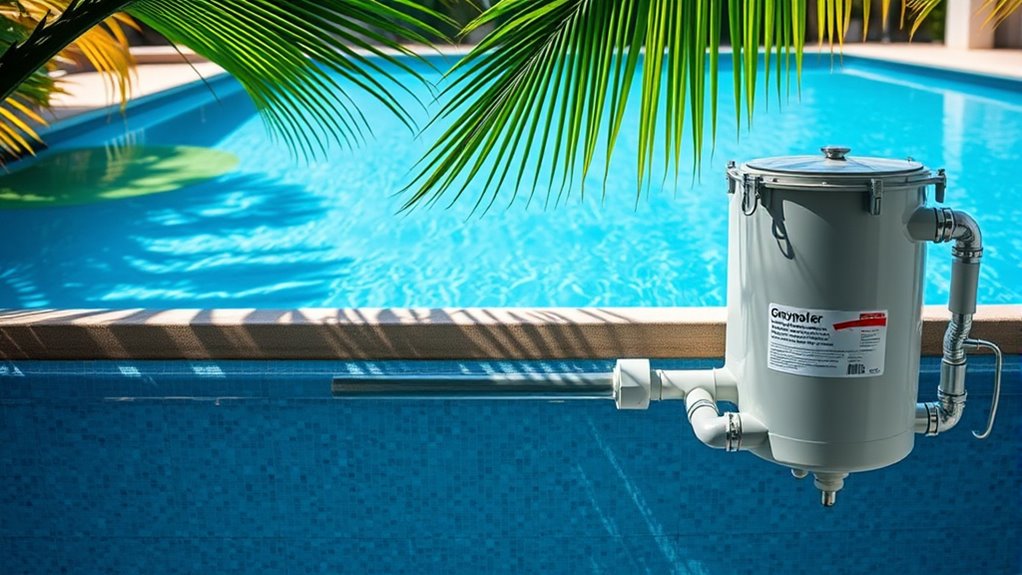To comply with discharge rules, you should know that greywater and backwash must be directed to approved areas like soil absorption beds or designated drain fields, avoiding storm drains, water bodies, or private property without permission. Regulations vary by location, and permits might be needed for larger volumes. Proper disposal methods include avoiding harmful chemicals and staying within local laws to prevent fines. Continuing to explore these guidelines will help you manage wastewater responsibly and stay compliant.
Key Takeaways
- Discharge greywater and backwash into approved drain fields, soil absorption beds, or designated infiltration areas to prevent environmental contamination.
- Avoid dumping greywater or backwash onto storm drains, lawns, or water bodies unless permitted by local regulations.
- Obtain necessary permits for large-volume discharges, and ensure systems meet setback and environmental criteria.
- Use eco-friendly cleaning agents and ensure greywater is free from harmful chemicals to protect groundwater and aquatic life.
- Regularly inspect and maintain disposal systems to ensure compliance, prevent failures, and minimize environmental impacts.
Understanding Greywater and Backwash Definitions

Greywater is the wastewater generated from household activities like bathing, laundry, and dishwashing, excluding sewage. It contains traces of soap, dirt, food particles, and other organic materials but typically doesn’t include human waste. Understanding this helps you recognize what qualifies as greywater and how it differs from blackwater, which contains sewage. Backwash, on the other hand, refers to the water used to clean filters in pools or water treatment systems. It often contains dirt, algae, or chemicals from pool maintenance. Both greywater and backwash are considered wastewater that can sometimes be reused or require specific disposal methods. Knowing these definitions helps you follow local regulations and manage waste properly, ensuring you avoid potential penalties and environmental harm. Additionally, awareness of pinball machine weights can be important if you are setting up or relocating equipment in recreational spaces.
Identifying Permitted Discharge Locations
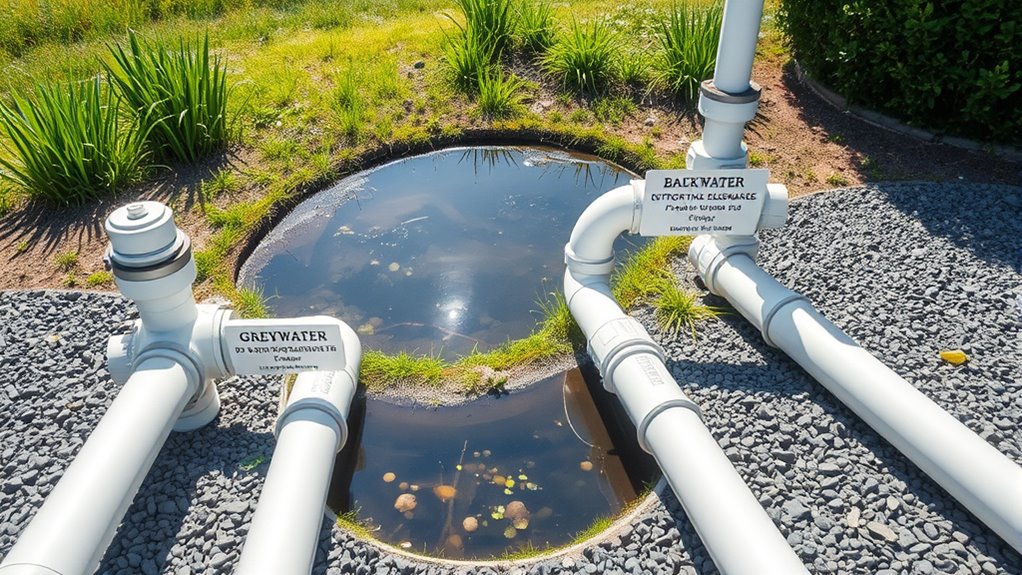
You need to know where you can legally discharge greywater and backwash to stay compliant. It’s essential to identify authorized sites and make sure they meet inspection requirements. Checking local regulations helps you select proper locations and avoid potential penalties. Understanding discharge site requirements can further ensure your system remains compliant with environmental standards.
Authorized Discharge Sites
Identifying authorized discharge sites is essential to guarantee that greywater and backwash are released safely and in compliance with regulations. You need to know where you’re allowed to discharge to avoid penalties and environmental harm. Approved sites typically include specific land areas, such as designated yards or infiltration basins, approved by local authorities. You must ensure the site is suitable for absorption, not near water sources or wetlands, and meets setback requirements. Always verify with your local health or environmental department for a list of permitted locations. Using unauthorized sites can lead to fines or enforcement actions. Before discharging, confirm the site’s approval status to stay compliant and protect the environment. Properly identifying authorized sites keeps your system safe and within legal boundaries. Additionally, understanding the design principles of farmhouse bedrooms can help ensure your space remains environmentally friendly and harmonious with natural surroundings.
Site Inspection Requirements
Before discharging greywater or backwash, inspecting the site to confirm it’s permitted is essential. You need to verify that the location complies with local regulations and isn’t restricted for such discharges. Look for designated areas like approved drain fields or approved surface waters. Check for any signage or posted restrictions indicating prohibited zones. Ensure the site won’t cause erosion, flooding, or contamination of nearby water sources. Confirm that the soil absorption capacity is adequate if discharging onto the ground. Take note of existing infrastructure and natural features that could be impacted. Proper site inspection helps prevent violations and environmental harm. Always document your findings, and if in doubt, seek clarification from local authorities before proceeding. Incorporating seasonal checklists can help ensure ongoing compliance and proper maintenance.
Local Regulatory Compliance
To guarantee compliance with local regulations, it’s essential to determine which sites are officially permitted for greywater and backwash discharge. You should contact your local environmental agency or review municipal codes to identify approved locations. Many jurisdictions restrict discharges to designated areas like sewer connections, approved soak zones, or specific treatment facilities. Avoid discharging in areas that could contaminate water sources, wetlands, or private property without permission. It’s also important to check for any permits or approvals required before proceeding. Keeping documentation of permitted sites and approval notices readily accessible is crucial. Staying informed about local rules ensures your discharge practices remain legal and environmentally responsible. Additionally, understanding the discharge regulations can help prevent accidental violations and protect natural resources.
Regulations for Residential Greywater Systems
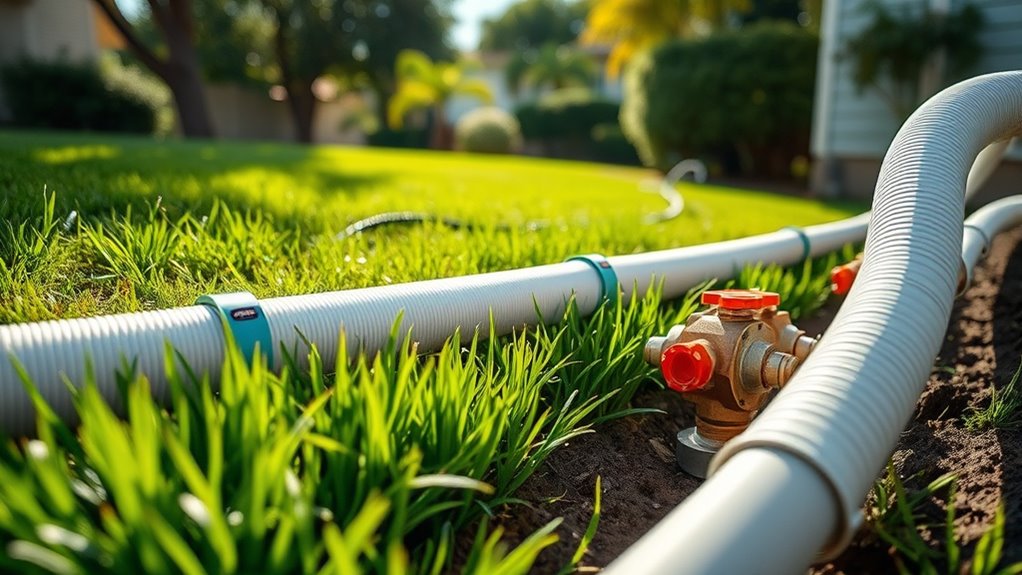
Understanding the regulations for residential greywater systems helps guarantee safe and legal discharge practices. You need to know where you can discharge greywater, what permits are required, and how to properly maintain the system. Staying compliant keeps your system working efficiently and avoids potential penalties.
Permitted Discharge Locations
Typically, residential greywater systems are permitted to discharge only in specific locations to protect environmental and public health. You should direct greywater away from storm drains, water bodies, and areas where it could contaminate groundwater or surface water. Discharges are often allowed on your property, such as landscaped yards, provided it doesn’t create nuisance or health hazards. You must avoid discharging greywater near wells, water sources, or where it could flow into public sewer systems unless approved. Sometimes, discharge zones are designated by local regulations, so it’s essential to check your jurisdiction’s rules. Properly selecting permitted discharge locations helps prevent pollution and guarantees your greywater system functions safely and legally. Additionally, understanding regulations for residential greywater systems can help ensure compliance with local environmental standards.
System Permitting Requirements
Before installing a residential greywater system, you need to obtain the proper permits from local authorities. These permits guarantee your system complies with safety and environmental standards. Typically, you’ll need to:
- Submit detailed plans showing system design and location.
- Obtain approval from local health or environmental departments.
- Meet specific setback distances from wells, septic tanks, or water bodies.
- Pass inspections during and after installation to verify compliance.
- Be aware of potential regulatory compliance challenges that may require ongoing adjustments or reporting.
The permitting process varies by location, so check your city or county regulations early. Some areas may require professional installation or certification. Failing to secure the necessary permits can lead to fines, system removal, or legal issues. Always start with your local agencies to ensure your greywater system is legal and safe.
Maintenance and Monitoring
Once you’ve secured the necessary permits for your greywater system, ongoing maintenance and monitoring become essential to keep it operating safely and efficiently. Regular inspections help you identify leaks, clogs, or system malfunctions early, preventing potential health hazards. You should routinely check filters, pumps, and pipes, cleaning or replacing parts as needed. Monitoring system performance also involves tracking water flow and ensuring proper discharge locations comply with local regulations. Keep detailed records of maintenance activities, inspections, and any repairs. Staying proactive reduces the risk of system failure and environmental contamination. Remember, adhering to maintenance schedules and monitoring requirements not only keeps your greywater system functioning smoothly but also ensures you remain compliant with discharge rules and safety standards. Using analytical cookies can help track system performance metrics and optimize maintenance efforts.
Pool Backwash Discharge Restrictions

Are you aware of the restrictions on discharging pool backwash water? Many local regulations limit how and where you can release this water. To stay compliant, consider these key points:
- Discharge is often only allowed into sanitary sewer systems, not storm drains.
- You may need a permit before discharging, especially for large volumes.
- The backwash must be free from chemicals or contaminants that could harm the environment.
- Discharges should be done during specific hours to minimize impact on neighboring properties.
- Regular use of glycolic acid products in skincare routines can improve skin clarity and texture, which may be relevant for those concerned about skin health after backwash discharge.
Failing to follow these restrictions can result in fines or environmental penalties. Always check your local regulations before discharging pool backwash water to avoid issues.
Proper Methods for Disposing of Greywater
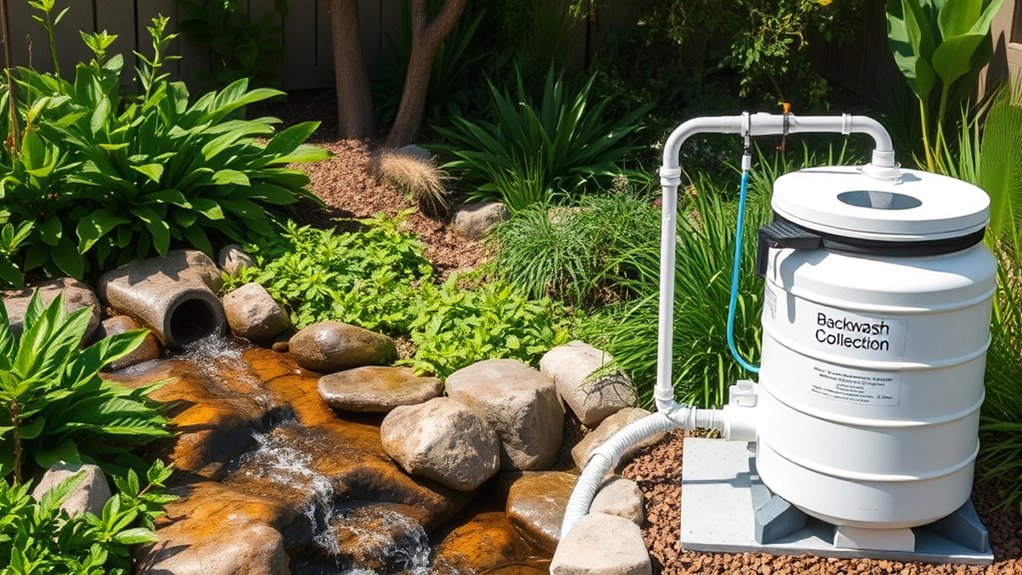
Proper disposal of greywater is essential to protect your home’s plumbing and the environment. To do this safely, avoid dumping greywater directly onto lawns or storm drains, which can cause contamination. Instead, consider using a designated greywater system or drain field designed for this purpose. If your system allows, direct greywater into soil absorption beds or soakaway trenches to naturally filter impurities. Always verify you’re not using harmful chemicals or soaps that can harm plants or groundwater. Regularly inspect and maintain your greywater disposal system to prevent clogs or leaks. Remember, proper disposal methods keep your plumbing functioning smoothly and safeguard surrounding ecosystems from pollutants. Following local regulations and guidelines guarantees environmentally responsible and safe greywater management. A higher contrast ratio in your home environment can also improve the visibility of your greywater systems, ensuring they function effectively and are easily monitored.
Environmental Considerations and Impact

Understanding the environmental impact of greywater and backwash disposal is crucial for maintaining ecological balance. Improper disposal can harm ecosystems, contaminate water sources, and disrupt local wildlife. To minimize these risks, consider the following:
- Water Quality: Contaminants in greywater can introduce pollutants into soil and groundwater.
- Soil Health: Excessive backwash can alter soil chemistry, affecting plant growth.
- Aquatic Life: Discharged greywater may contain chemicals harmful to aquatic organisms.
- Groundwater Recharge: Uncontrolled disposal can lead to groundwater contamination, impacting drinking water supplies.
Being mindful of these factors helps ensure your disposal practices support environmental health and sustainability. Proper management reduces pollution risks and preserves natural resources for future generations.
Local and State Regulatory Compliance
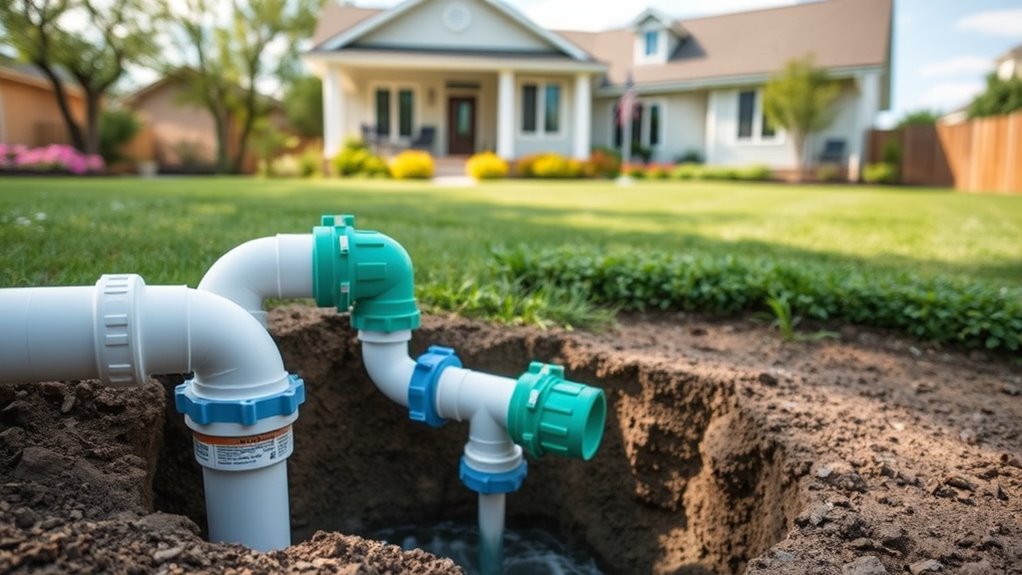
Navigating local and state regulations is essential to guarantee your greywater and backwash disposal practices stay legal and environmentally responsible. Start by researching your specific jurisdiction’s rules, as they can vary widely. Many areas require permits or approvals before discharging greywater or backwash, and some may have restrictions on where you can drain it. Keep in mind that state agencies often set overarching guidelines, but local authorities enforce them, so always check with both levels. Failing to comply can lead to fines, cleanup orders, or other penalties. Stay informed about updates to regulations, and document your compliance efforts. Consulting with environmental agencies or professionals can help ensure your practices meet all legal requirements, avoiding potential issues down the line.
Common Penalties for Non-Compliance
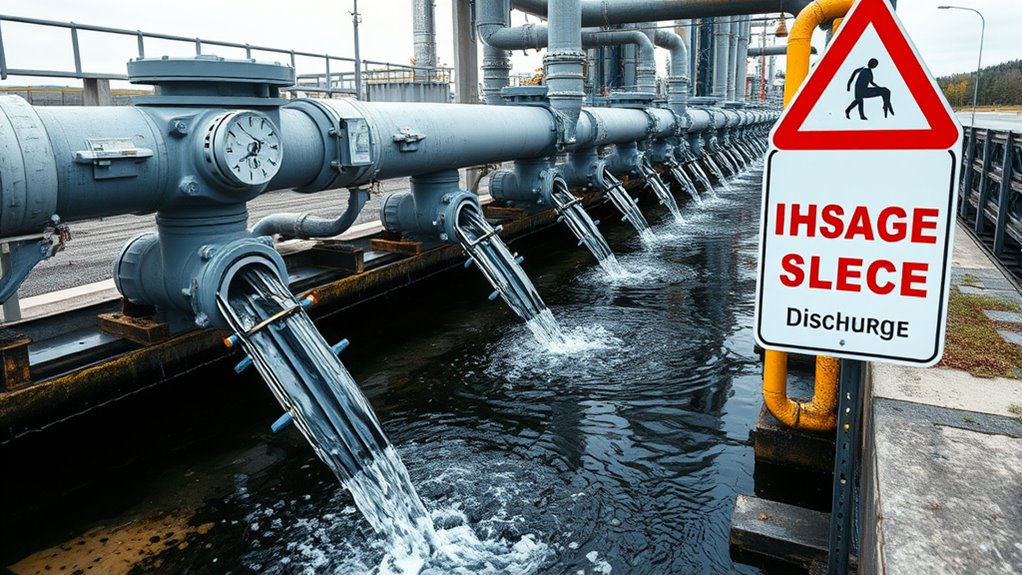
Failing to comply with greywater and backwash regulations can result in serious penalties that impact both your finances and reputation. You might face fines that increase with each violation, making non-compliance costly. Authorities can also impose mandatory cleanup procedures, requiring you to remove improperly discharged water. In extreme cases, violations could lead to legal action, including lawsuits or court orders to cease operations. Additionally, your reputation could suffer, deterring clients or partners who prioritize environmental responsibility. Here are some common penalties you might encounter:
Ignoring greywater and backwash rules can lead to costly fines, legal action, and reputation damage.
- Fines that escalate with repeated violations
- Mandatory remediation and cleanup costs
- Legal actions or court injunctions
- Damage to your business reputation
Best Practices for Safe Discharge Management
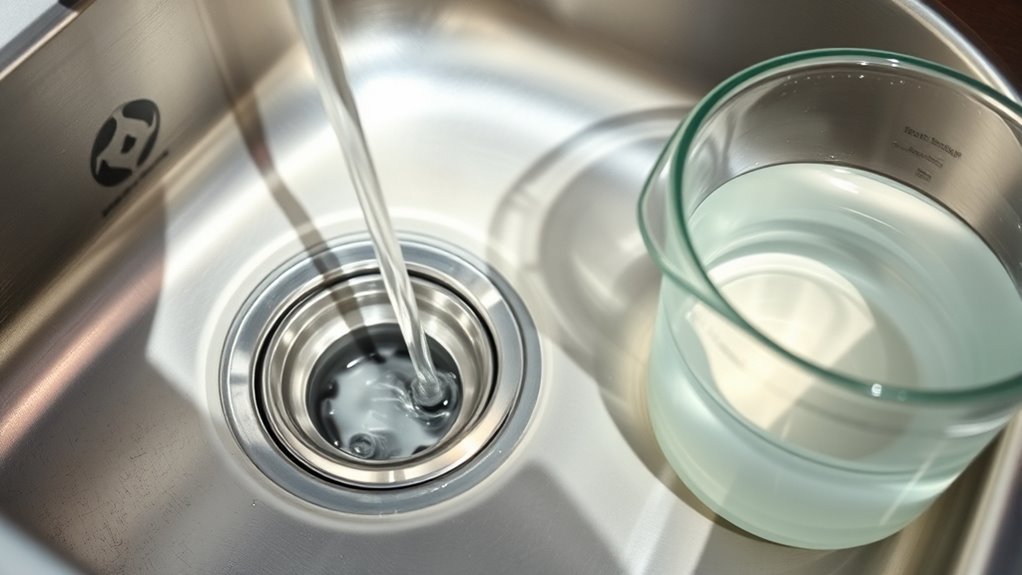
To guarantee safe discharge management, you should always use proper disposal locations that comply with local regulations. Regular system maintenance helps prevent issues and keeps your setup functioning properly. Additionally, choosing eco-friendly products reduces environmental impact and promotes sustainable practices.
Proper Disposal Locations
Choosing the right disposal location is essential for ensuring greywater and backwash are managed safely and environmentally responsibly. You need to select sites that prevent contamination and comply with local regulations. Consider these options:
- Drip fields or leach beds designed for greywater, which allow natural filtration and absorption into the soil.
- Dedicated underground injection wells, approved for backwash disposal, ensuring no surface runoff.
- Natural water bodies, if permitted, with proper distance from wells and water sources to avoid pollution.
- Approved drainage systems that direct wastewater to municipal or approved treatment facilities.
Always confirm that your chosen location aligns with local codes and environmental best practices to protect water quality and public health.
Regular System Maintenance
Maintaining your greywater and backwash systems regularly helps guarantee safe and effective discharge management. You should inspect your systems frequently for leaks, clogs, or damage, ensuring all components function properly. Clean filters and screens to prevent blockages that could cause backups or contamination. Check pumps and valves to verify they operate smoothly and are not corroded or worn out. Schedule routine maintenance based on manufacturer recommendations or local regulations, and keep detailed records of inspections and repairs. Proper maintenance extends system lifespan and minimizes environmental risks. Always address issues promptly to avoid costly repairs or violations. By staying proactive, you ensure your discharge processes remain compliant, safe, and environmentally responsible. Regular upkeep is key to long-term system reliability and peace of mind.
Use of Eco-friendly Products
Using eco-friendly products in your greywater and backwash systems is essential for safe discharge management. These products help protect the environment and guarantee your system operates efficiently. When choosing cleaning agents, opt for biodegradable and non-toxic options to prevent harmful chemicals from contaminating water sources. Here are some best practices:
- Use natural cleaning solutions like vinegar, baking soda, or plant-based detergents.
- Avoid products with phosphates, chlorine, or synthetic fragrances.
- Regularly check labels for eco-certifications indicating safe, biodegradable ingredients.
- Limit the use of harsh chemicals that can harm beneficial bacteria in your system.
Resources for Staying Updated on Discharge Rules

Staying informed about discharge rules for greywater and backwash is essential, and there are several reliable resources to help you do so. Start by visiting your local environmental agency’s website, which often provides updated regulations and guidelines. Industry associations and professional groups, like the Water Quality Association, also offer valuable resources, including newsletters and webinars. Subscribing to relevant government alerts ensures you receive real-time updates on policy changes. Local ordinances may vary, so check with your city or county’s public works department regularly. Additionally, online forums and community groups can offer practical advice from others managing greywater systems. Staying proactive with these resources helps guarantee your practices comply with current rules and protect the environment.
Frequently Asked Questions
Are There Specific Permits Required for Greywater and Backwash Discharge?
Yes, you typically need permits for greywater and backwash discharge. You should check with your local or state environmental agency to see specific requirements, as rules vary by location. Applying for the right permits guarantees you’re compliant with regulations and helps prevent fines or legal issues. Make sure you understand the guidelines for proper disposal, and submit all necessary documentation before discharging greywater or backwash from your system.
How Do Discharge Rules Differ Between Urban and Rural Areas?
Think of urban areas as tightly woven tapestries, where discharge rules are strict threads ensuring harmony. Rural zones are open fields, allowing freer flow but still respecting boundaries. You’ll find stricter regulations in cities to prevent pollution, often requiring permits. In contrast, rural areas may have more relaxed rules, focusing on conservation and natural infiltration. Always check local regulations, as these rules act as the fabric holding environmental health together.
Can Greywater Be Reused for Irrigation Legally in All Regions?
You can’t reuse greywater for irrigation legally in all regions. Laws vary widely depending on your location, with some areas allowing it under specific conditions and others prohibiting it altogether. You need to check local regulations before reusing greywater, as improper use can lead to fines or health hazards. Always consult your local health or environmental authorities to make certain you’re following the legal guidelines for greywater reuse in your area.
What Are the Health Risks Associated With Improper Backwash Disposal?
Think of improper backwash disposal as releasing a hidden poison into your environment. It can carry bacteria, viruses, and chemicals that threaten your health and nearby ecosystems. You might develop infections or gastrointestinal issues, and local water sources could become contaminated, affecting wildlife and community safety. To protect yourself and others, always follow proper disposal procedures, treating backwash as a hazardous substance that demands respect and careful handling.
How Often Should Systems Be Inspected to Ensure Compliance?
You should inspect your system at least once every three to six months to guarantee compliance. Regular checks help identify potential issues early, preventing health risks and legal violations. During inspections, look for leaks, blockages, and proper discharge practices. Maintaining a consistent schedule keeps your system functioning efficiently and ensures you meet all discharge rules, reducing environmental impact and safeguarding public health.
Conclusion
Think of greywater and backwash rules as guiding stars in your responsible discharge journey. By following these regulations, you steer your actions away from hidden reefs of fines and environmental harm. Staying informed and compliant keeps your vessel steady, ensuring safe waters for everyone. Remember, each proper disposal method is a lighthouse guiding you toward sustainability, illuminating a future where your choices reflect respect for our shared environment. Navigate wisely, and lead the way toward cleaner, safer waters.
